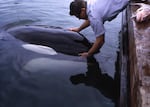If you want to know how our relationship with wildlife has changed, consider how two different Seattle aquariums provided their visitors up-close encounters with one of the world’s largest predatory sharks.
In the 2000s, the Seattle Aquarium used underwater cameras so guests could watch sixgill sharks glide through the waters of Elliott Bay.
Back in the 1960s, when the now-defunct Seattle Marine Aquarium wanted to create a sixgill shark attraction, its proprietor went out to catch them and put them in a tank.
Seattle Marine Aquarium owner Ted Griffin had heard rumors about the big sharks, becoming obsessed with the idea of catching them.
“I have to do it. I have to get one. Somehow, some way I have to get one of these sharks," he recalled saying to himself at the time.
Sixgills eat a wide range of marine species, including other sharks, rays, squid, crab, shrimp and sometimes seals.
WATCH Wildlife Detectives: Mystery Sharks of Seattle
And it turns out they also like bacon. That’s what Griffin used as bait to catch his first shark in 1964. It was 8 feet long.“When I went out and started pulling, the boat started to be towed by this shark,” Griffin said. Griffin and his partner put the shark on a stretcher tied to the side of the boat and transported it back to the harbor.
Griffin ended up catching two sharks within a few months. He put them in an open-air tank with some seals. Visitors lined up outside to get a look at Griffin’s sharks. As part of the show, Griffin would get in the tank with the sharks and take them for a “walk.” He would also open the sharks’ mouths so visitors could see their jaws.
“You walk around, and you hold the shark under your arm and when you get to one of the sides of the aquarium you open the mouth, and you just lift up on the nose or the snout, and you can see the teeth very nicely,” Griffin said.
Sixgill sharks are deep-sea creatures. They spend much of their lives hundreds or thousands of feet below the surface. Their eyes are sensitive to bright light.
Griffin recalled how one of the captive sharks would try to swim but ran into the sides of the tank.
“He bumped his nose a few times, and it became quite bruised,” Griffin said.
Occasionally the sharks would end up stuck in the corners of the pen and divers would have to help them turn around. If sharks can’t move freely, they can’t draw oxygen in through their gills and will die.
After a few months, Griffin decided he could no longer keep sharks. Today no U.S. aquariums keep sixgills.
By today's standards, capturing sixgill sharks for the amusement of paying customers would almost certainly draw animal-rights protests like those that recently galvanized public opinion against SeaWorld for its treatment of captive orcas.
But Griffin insists that his capturing and displaying of sharks actually did some good by challenging mid-20th century attitudes about these creatures.
MORE ONLINE: Searching For The Mysterious Sixgill Sharks Of The Puget Sound
“People’s reactions to the sharks changed pretty markedly when they saw our sharks not gobbling down people,” he said. “They very soon came to realize that the sharks were not dangerous but the mystery, the mystery of this huge creature living in Puget Sound and nobody ever knew it was there.”
Griffin moved on from captive sharks to captive orcas. After protests and legal action against Griffin for capturing wild killer whales for public display, the aquarium closed in 1976.

In 1965 Ted Griffin purchased the orca Namu, after it was accidentally caught in a fishing net. Namu was on display and performed for audiences at the Seattle Marine Aquarium.
Courtesy of Ted Griffin